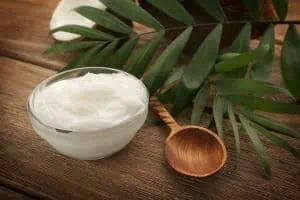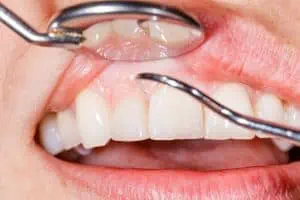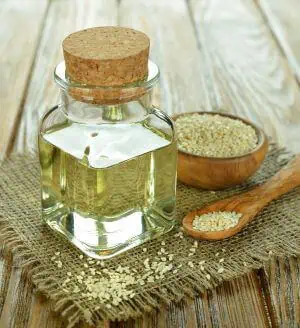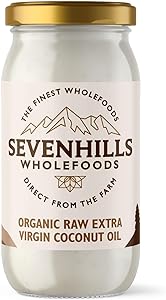Oil pulling isn’t just the latest natural tooth care fad being touted by Millennials and eco bloggers. It’s actually an ancient Ayurvedic folk remedy practised in India.
Promotors of this natural remedy claim it has many benefits, not just for your dental health but for your overall health in general. But is there any substance to these claims? And can they be backed up by science?
In this article, we’ll get to the bottom of oil pulling for teeth – whether using coconut oil or other types – and discuss all you need to know about this practice, including:
- Oil pulling benefits
- Coconut oil pulling dangers
- How to do it
- The different types of oil you can use
- Whether you can really use oil pulling for teeth whitening
After reading this article, we hope you feel armed with the information you need to decide if you want to buy that recycled glass jar of organic coconut oil on Amazon, or instead look around for some other alternatives.
In This Article
What is oil pulling?
Oil pulling involves swishing edible oil, usually coconut oil, around your mouth for around 20 minutes at a time.

This process is an ancient Ayurvedic practice to aid in maintaining good oral hygiene. It is a therapy mentioned in the Charaka Samhita, one of the two foundational texts on Ayurvedic medicine. It was introduced in the Western world by Dr. Karach in the 1990s, as a way to fight against immune disorders and treat other illnesses.
Today, this practice is still used for its supposed health benefits, along with whitening teeth and freshening breath.
What are the health benefits of oil pulling?
Traditional sources claim a plethora of health benefits that can be gleaned from oil pulling. In fact, in the Charaka Samhita it is said to be able to cure around 30 systematic diseases, and in general Indian folk medicine it was used to:
- Prevent tooth decay
- Cure oral malodor
- Cure bleeding gums
- Prevent dry throat
- Prevent cracked lips
- Strengthen teeth and jaw
It was also used to cure ailments not directly related to the mouth, such as diabetes, migraines and asthma.
The touted benefits of oil pulling in the present day do overlap and include the following:
Reducing harmful bacteria
The main reason that people oil pull today is to reduce the number of harmful bacteria that can be found in your mouth. The principal harmful bacteria targeted by this practice is streptococcus mutans. This is the main bacteria that aids in the buildup of plaque, which then can lead to tooth decay.
Reducing the risks of gingivitis
Gingivitis, or gum disease, is a condition that occurs when your immune system attacks the bacteria in the plaque around your gums, and causes them to become red, inflamed and even to bleed. Oil pulling is said to reduce the inflammation in your gums and also the plaque that causes that inflammation. You may, therefore, see noticeable results if you start using oil pulling for gum disease treatment.
We have more advice about how to stop bleeding gums in our separate guide.
Goodbye, bad breath!

Do you suffer from bad breath or halitosis? If so, first you should read our full guide to bad breath.
It also turns out that you may want to consider oil pulling to help freshen up that breath. That’s because foul-smelling breath is caused by a buildup of bacteria in your mouth that produce bad smells, so since oil pulling gets rid of some of that smelly bacteria, it also helps get rid of unpleasant odours in your mouth.
Keep in mind that all of the benefits mentioned in this article are to be taken with a grain of salt, as many professionals in the dental community say there isn’t enough science-based evidence to back up these touted benefits, and that some of the studies that have been produced aren’t very reliable.
Oil pulling for teeth whitening
One way some people use coconut oil in modern times is for a natural way to whiten teeth. The thinking behind oil pulling and teeth whitening is that oil helps get rid of plaque, which is one of the reasons your teeth may appear yellow. That being said, there really isn’t a lot of evidence to back up the whitening effects of coconut oil on teeth. However, nor is there significant research that says that it doesn’t whiten teeth. For now, coconut oil teeth whitening is a subject that lacks enough research for a definitive answer.
In the video below, Alistair reviews his oil pulling results after trying it for a whole year after his holistic dentist recommended it. He mentions:
- Some teeth whitening
- Bleeding gums have completely stopped (which his dentist and hygienist also noticed)
- Clearer sinuses
- Fewer coughs and colds over the winter
If you want more drastic teeth whitening results, you’re probably better off looking at a stronger teeth whitening method instead and avoiding these whitening myths.
Does oil pulling work?
Although there isn’t extensive research on the benefits of oil pulling, there are some studies that have been conducted. One of which is this one from the Journal of Indian Society of Periodontology, in which one group of people practised oil pulling and the other used chlorhexidine mouthwash for up to two weeks. The results were that the number of streptococcus mutans, acid-producing bacteria known to cause decay, in the plaque of the group using oil pulling was significantly reduced.
Another study from the Journal of Natural Science, Biology and Medicine looked at patients with plaque-induced gingivitis. One group carried out a normal oral hygiene routine and the other group did the same but added oil pulling. The results of this study were that the reduction of plaque was more pronounced in the participants who practised oil pulling.

Do note that although this practice may be able to reduce plaque on teeth, it won’t have any effect on tartar – a hard substance which forms after plaque is left for too long. Tartar can only be removed by a dentist with teeth scaling.
Despite the existence of some studies that support claims that it is beneficial to oral health, you can also find plenty of scholarly articles. Like this one from a doctor at the Department of Public Health Dentistry at Sri Siddhartha Dental College in India, that says that the existing studies are unreliable due to the misinterpretation of results, too small of sample size and absence of negative controls, among other factors. And that there simply aren’t enough scientific studies that provide clinical evidence demonstrating that oil pulling is, in fact, effective in reducing dental caries, whitening teeth or improving oral health in general.
Are there any risks or dangers?
According to the American Dental Association, the limited studies available for the health effects, including the potential benefits and risks of oil pulling puts into question the efficacy and safety of this practice. They cite one of the potential risks of oil pulling as including lipoid pneumonia, an inflammation of the lungs from fat particles, and another of the risks as diarrhea. There is no specific advice on coconut oil pulling from the NHS, however.
Another concern is that the oil used for pulling might contain harmful additives. Harvard Medical School conducted a study of the Ayurvedic products available in South Asian grocery stores in Boston and found that 1 in 5 products contained potentially harmful levels of lead, mercury and/or arsenic.
However, the greatest potential risk of oil pulling comes from using this practice to replace a healthy oral hygiene routine that includes proper brushing and flossing and regular visits to the dentist.
Have a look at the following table for a summary of the pros and cons of oil pulling. Although keep in mind, as we said earlier, that there is limited scientific research into this practice.
[su
Pros | Cons |
Decreases harmful bacteria in the mouth | Time consuming |
Helps heal bleeding and inflammed gums | Can cause stiff and sore mouth muscles |
Naturally whitens teeth | Not an efficient whitener |
Helps prevent cavities | Lack of evidence to back up health benefits |
Inexpensive | |
Can be done at home |
How to do oil pulling
If you do decide that you would like to try oil pulling with coconut oil – or indeed sesame or olive oil – the good news is that it’s pretty easy to do. Just follow these steps:
- Measure out one tablespoon of edible oil. Coconut, sesame and olive oil all work, but a lot of people prefer coconut oil because it tastes the best.
- Swish the oil around your mouth for up to 20 minutes, and don’t swallow any.
- Once your 20 minutes are up, spit the oil into the bin (spitting it into the sink can clog your drain).
- Rinse your mouth, thoroughly.
In the video below, one oil pulling fan named Donna shows how she does it:
She adds the following tips:
- Do your oil pulling in the shower to make it a part of your daily routine
- Combine it with meditation if that’s something you like to do
- Use a cold-pressed organic virgin coconut oil like this one from Sevenhills Wholefoods
What is the best oil for oil pulling?
If you want to follow traditional Ayurvedic practices for your oil pulling routine, then you should use sesame oil. However, coconut oil is the most popular oil to use for pulling present-day. That’s because many people are drawn to its numerous antioxidants and anti-inflammatory agents. It also contains lauric acid, which is effective at killing harmful bacteria that could lead to tooth decay. And of course, coconut oil tastes better!

That being said, any edible oil will work, including olive oil, but for the best results, make sure to use unrefined, organic oil.
How often should I oil pull?
To achieve any of the potential effects of oil pulling, you should keep the oil moving in your mouth for 5 to 20 minutes anywhere from a few times a week, up to three times a day.
It should be noted that your mouth muscles may tire of swishing pretty quickly when you first try it, so you might have to slowly build up the time that you swish for.
It can also take a while to get used to the consistency of the oil in your mouth, especially if you’re in a colder climate and it solidifies when you store it.
Where to buy pulling oil

While you can certainly use the coconut oil or sesame oil that you have at home to oil pull, you’ll find a great range of products in health food shops and on Amazon. As mentioned above, you’ll get the best results from using an unrefined, organic product.
If you’d like to try oil pulling with coconut oil, you can buy some all-purpose organic, extra-virgin coconut oil like this one from Sevenhills Wholefoods. This coconut oil is suitable for teeth pulling as well as for all kinds of cooking and beauty uses, so it’s worth investing in a large jar.
If you’re really a purist and want to use sesame oil as is used in Ayurvedic practices, then this organic sesame seed oil from Naissance may be the product for you.
You can also purchase an oil made specifically for oil pulling, like this mouthwash from Georganics. This product is made from coconut oil blended with spearmint oil and activated charcoal, another ingredient known for its natural whitening properties.
The charcoal adds a slightly abrasive texture to the oil, so the recommended usage time is 5-20 minutes. Many people find the minty taste far more pleasant than putting raw coconut oil in their mouths.
It is also possible to make your own homemade organic mouthwash if you like the idea of natural mouthwashes with these ingredients.
Conclusion
Oil pulling is not a practice that is backed up by tons of modern science. However, it is an ancient practice that comes from Ayurvedic medicine in India and has many supposed benefits — check out our article on turmeric for whitening.
Those who have added oil pulling to their oral hygiene routine claim that its benefits include whiter teeth and an overall healthier mouth with less harmful bacteria. If you do want to try it, be sure to not swallow the oil, and always use oil that is edible and preferably organic as well. And the most important thing to keep in mind—don’t use it to replace daily brushing and flossing!

FAQs
What time of day should I oil pull?
Oil pulling can be performed at any time of day, but if you want to follow traditional Ayurvedic practices, you should oil pull first thing when you wake up in the morning, before eating or drinking.
The idea behind this is that oil pulling helps get rid of harmful bacteria in your mouth that has built up overnight, and when you spit it out, you’re also spitting out all of that bacteria. If you eat first, you just end up swallowing that bacteria.
However, if this isn’t practical for you, you can build it into your routine at any time of day. Oil pulling at night should, in theory, mean that there are fewer bacteria in your mouth as you sleep.
Do you brush your teeth before or after oil pulling?
You don’t need to brush your teeth before oil pulling, because it will, in theory, get rid of some plaque and bacteria for you. You can, however, brush your teeth afterwards. If you don’t brush your teeth directly after oil pulling, make sure to rinse your mouth out really well. And whether you oil pull or not, you should brush your teeth when you normally would, at least twice a day.
What are some possible coconut oil pulling dangers?
In a worst-case scenario, negative side effects can include dry mouth, muscle stiffness, exhaustion, loss of taste, excessive thirst, lipid pneumonia and diarrhoea. That sounds pretty bad, but this is if you use an improper technique, or perform it too many times or for too long throughout the day. Your dentist might say that the most negative side effect of all from oil pulling would be those that occur from using it to replace a proper oral hygiene routine that includes brushing and flossing twice a day.
Is oil pulling healthy?
There’s not enough scientific evidence to say definitively whether or not oil pulling is healthy. It is certainly an ancient practice and an important part of Ayurvedic medicine. Many people who do oil pull claim countless health benefits, and even a whiter smile. And while there’s no concrete evidence that it’s healthy, there’s also not overwhelming evidence that it’s unhealthy, at least when done correctly. So if you want to try it, follow the instructions mentioned in this article and pull away! (And maybe talk to your dentist first).
Can receding gums grow back from oil pulling?
Although oil pulling can be beneficial for gum health, it’s not possible to make receding gums grow back using this or any other remedy, because the gum tissue has been damaged beyond repair.
This practice may help stop receding gums, and after that you can look at your options for repairing the damage.
Does oil pulling heal cavities?
Removing plaque is one thing, but pulling oil cannot reverse cavities or damage to tooth enamel from decay. Read our article about enamel repair and remineralization for some ways to heal early stage tooth decay.
Journal of Traditional and Complementary Medicine: Oil pulling for maintaining oral hygiene – A review. Consulted 13th February 2020.
Journal of Ayurveda and Integrative Medicine: Tooth brushing, oil pulling and tissue regeneration: A review of holistic approaches to oral health. Consulted 13th February 2020.
Journal of Indian Society of Pedodontics and Preventive Dentistry: Effect of oil pulling on Streptococcus mutans count in plaque and saliva using Dentocult SM Strip mutans test: a randomized, controlled, triple-blind study. Consulted 13th February 2020.
Journal of Natural Science, Biology and Medicine: Comparing the effect of coconut oil pulling practice with oil pulling using sesame oil in plaque-induced gingivitis: A prospective comparative interventional study. Consulted 13th February 2020.
Journal of the American Medical Association: Heavy metal content of ayurvedic herbal medicine products. Consulted 13th February 2020.




